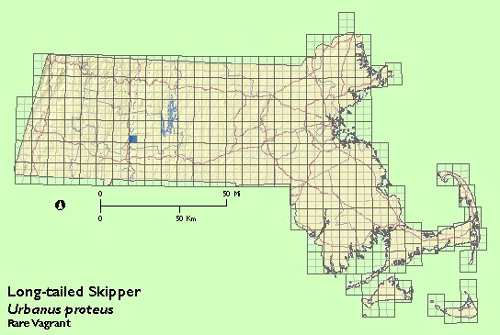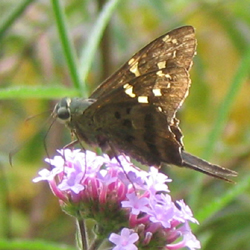Find a Butterfly
Long-tailed Skipper
Urbanus proteus
Named
Linnaeus, 1758

Identification
Wingspan 1 1/2 - 2". May be told by robust body, long (1/2") hindwing tails, and bright greenish iridescent sheen on head, thorax, and basal areas of both wings. Sexes similar. The Silver-spotted Skipper, which is similar in size and flight behavior, lacks the distinctive tails of the Long-tailed Skipper, its iridescence, and has a large silver spot on the hindwing below (the hindwing below in the Long-tailed Skipper is brown, crossed by two darker bands).
Distribution
Across the southern United States from southern California to Florida, and south throughout the West Indies, Mexico, Central and South America to Argentina. Strays north to Midwest and along the east coast to southern New England.
Status in Massachusetts
The Long-tailed Skipper is a vagrant in New England. Scudder mentions one record from New Haven, CT (Smith). The first Massachusetts records are from 1990, when two individuals were discovered, one in So. Hadley (Hampshire Co.), T. Fowler on 2 September, the other in Marshfield (Plymouth Co.), D. Clapp on September ————. These were the northernmost reports from a significant fall flight of the species in 1990. Another flight in 1994 produced single Long-tailed Skippers at Foxboro (Norfolk Co.), B. Cassie, on 10 September and So. Hadley (Hampshire Co.), T. Fowler, on 12 September.

Flight Period in Massachusetts
Year-round in the South. It is most likely in New England in late summer or fall, when northbound emigrants from the permanent southern population make far-ranging flights.
Larval Food Plants
Legumes, including cultivated bean varieties, Wisteria, and beggar‘s ticks (Desmodium, sp.) are fed upon. Crucifers and monocots have been reported, but are probably erroneous (Opler and Krizek).
Adult Food sources
A variety of flowers is visited avidly throughout the species‘ range. Massachusetts specimens were taken at zinnias and buddleia.

Habitat
Open, disturbed areas are preferred, including roadsides, brushy fields, streamsides, and gardens.
Life Cycle
EGG: Pale yellow or buish-green; hemispherical with vertical ridges. OVIPOSITION: Eggs laid in groups of up to 20, typically on the underside of host plant leaves. LARVA: Green to gray, lined with black down the back, yellow and green on the sides; head blackish-brown with yellow-orange spot on each side. CHRYSALIS: Reddish-brown, with white, powdery covering. OVERWINTERING STAGE: Flies year round. Larvae of Long-tailed Skippers are known as Bean-leaf Rollers in the South, where their numbers can sometimes cause serious crop damage. Mass northward emigrations may result from immense population build-ups in southern states, but the species is unable to withstand freezing temperatures and dies out north of its permanent range. The flight is erratic and fast.
Account Author
Tim Fowler
Additional Information
Read more on this species at the North American Butterfly Association.



